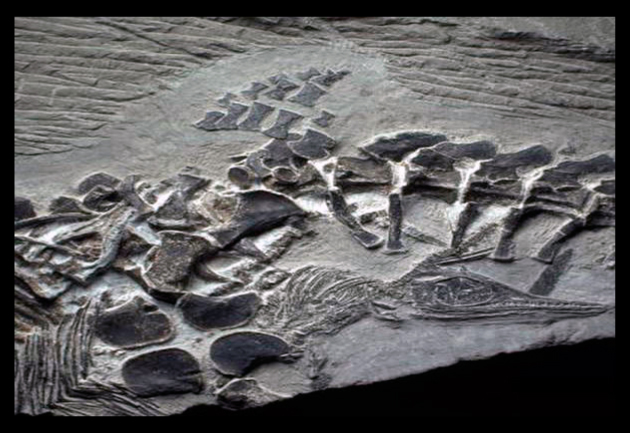http://www.darwinthenandnow.com/2014/02/new-reptile-fossil-stuns-evolution-paradigm/
Taken from the highly informative blog “Darwin Then & Now” from the writer of the excellent book by the same title.

New fossil discovery in China stuns Charles Darwin’s theory of evolution acting through “slight successive changes.” An international team led by geologist Ryosuke Motani from the University of California at Davis published a paper in PLOS journal earlier this month on new evidence that foils previous evolution paradigms.
Bordering on the Yangtze River in the eastern China just north of Chaohu City, Motani’s team discovered by accident what is thought to be the oldest known reptile. While working systematically through a slab of entombed fossils looking for a ray-finned fish known as Saurichthys, the workers accidently fractured the slab.
Within the fractured slab the team discovered an “an articulated embryo in birth position, with its skull just emerged from the maternal pelvis.” The young reptile mother (approximately 40 inches long) was fossilized while giving live birth to three young ones. The “new fossil specimen,” according to Motani, “strongly contradicts this traditional interpretation.”
Chaohusaurus is the name given to the fossil; “Chaohu” indicating the site found linked with the generic name for a lizard – “saurus.” Currently thought to be the oldest discovered reptile birth ever known, the fossil has also been variably called Anhuisaurus or Chensaurus since first described in 1972 by CC Young and Z-M Dong.
One of the embryos (each approximately 7 inches long), was inside the mother, one was exiting the pelvic girdle with half of the body still in the maternal body cavity, and the third had just exited. The report documents that the “preservation of embryos is exquisite despite the great geologic age.”
Viviparity is the term given for the process of the fertilized eggs to develop within an embyro inside the body of the mother eventually leading to the delivery of a live new born. While most reptiles lay amniotic eggs covered with leathery or calcareous shells, several marine [and many land-dwelling] reptiles exhibit viviparity, including mosasaurs, Sauropterygia and the ichthyosaurs.
While thought to be similar to Cymbospondylus and Mixosaurus, and Ichthyosaurus genera, Chaohusaurus is classified as a distinct genera without any known transitional links – a somber problem for the theory of evolution acting through Darwin’s expected “slight successive” changes.
Extending problematical transitional links is the “head-first” orientation (see photograph). While land-based viviparous animals “head-first” is the norm, marine-based animals “tail-first” is the norm−like mammals. The fossil evidence for Ichthyosaurus genera demonstrate “tail-first” viviparity.
“We always assumed that live-bearing in marine reptiles evolved after they invaded the sea, partly because of this difference [evidence to suggest tail-first births]” Motani noted in an interview. “Now the new fossil shows that the most primitive marine reptile gave birth head first. This strongly suggests that they inherited live-bearing from their land ancestors.”
Unlike all other known reptiles, the evidence point to a land [terrestrial] origin of viviparity as is reflected in the title of the paper: “Terrestrial Origin of Viviparity in Mesozoic Marine Reptiles Indicated by Early Triassic Embryonic Fossils.”
“Terrestrial origins of viviparity,” however, Motani explains, in “marine reptiles may be a departure from the conventional wisdom” since “there is no evidence for a marine origin of viviparity.” With this new reptile fossils, the evolution paradigm has been stunned, again.
Reproduction has long stymied the theory of evolution. The duck-billed oddity, the Platypus, is a mammal laying eggs. During the five year voyage aboard the HMS Beagle, while in Australia Darwin recorded the blatant evolution paradox by noting:
“had the good fortune to see several of the famous Platypus or Ornithorhyncus paradoxicus.”
As a paradox, Darwin conveniently never mentions the Platypus in The Origin of Species. This exclusion further exemplifies Darwin’s method of distorting science to save the theory. This signature method of investigation adopted by Darwin is highlighted in the article “Darwin Day, the Ultimate Science Paradox.”
Richard Gibb, Director of the Human Genome Sequencing Center at Baylor College of Medicine in Texas, notes, “there is nothing quite as enigmatic as a platypus…. It all points to how idiosyncratic evolution is.”
Australian biologist, Michael Archer wrote, “Indeed, evolutionary scientists are baffled about the ancestry of the platypus.”
The scientific evidence simply declares that the fossil record demonstrate a mosaic pattern of nature−not an evolutionary pattern. By contrast, a mosaic pattern is compatible with the Genesis account of nature.
Angst even within the evolution industry has finally reached a tipping point. In an interview by journalist Suzan Mazur in the book The Altenberg 16: An Expose of the Evolution Industry, cell biologist Stuart Newman of the New York Medical College sounded the alarm:
“Unless the discourse around evolution is opened up to scientific perspectives beyond Darwinism, the education of generations to come is a risk of being sacrificed to the benefit of a dying theory.”
Frustrated adherence to Darwin’s outdated theory, National Medal of Science winner presented by President Bill Clinton, Lynn Margulis in an interview with Mazur pronounced
“neo-Darwinists are a… religious sect within the sprawling religious persuasion of Anglo-Saxon Biology.”
The vanishing existence of “slight successive changes” in found in the fossil record for reptile reproduction exemplifies why this once powerful icon of evolutionary theory, Darwinism, is now dead.
Evolution was once a theory in crisis, now evolution is in crisis without a theory.
For these reasons, biological evolution only exists as a philosophical fact−not as a scientific fact.

Thanks for letting me know about this blog/book! What a sad, but fascinating find.